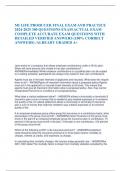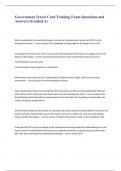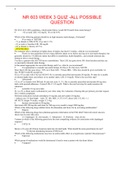MI LIFE PRODUCER FINAL EXAM AND PRACTICE
2024-2025 300 QUESTIONS EXAM ACTUAL EXAM
COMPLETE ACCURATE EXAM QUESTIONS WITH
DETAILED VERIFIED ANSWERS (100% CORRECT
ANSWERS) /ALREADY GRADED A+
Jane works for a company that allows employee contributions under a 401(k) plan.
When will Jane become fully vested in her plan contributions? -
ANSWERimmediately//While employer contributions to a qualified plan can be subject
to a vesting schedule, participants are always fully vested in their own contributions.
Agents must act in the best interests of applicants and insureds. What does this require
them to do? - ANSWERgive all important information about a proposed policy//Agents
must act in the applicant's or insured's best interests at all times. This means that
agents must give all important information about a proposed policy. Also, they cannot
misrepresent the terms or conditions of a proposed policy.
What does a viatical settlement allow? - ANSWERIt allows a chronically or terminally ill
insured to gain a sum of money that is needed to pay medical expenses or to enhance
the quality of life.//A viatical settlement allows a chronically or terminally ill insured to
gain a sum of money that might be needed to pay medical expenses or to enhance
quality of life.
If an employer/employee group offers group life insurance on a contributory basis, what
percentage of the group must enroll? - ANSWERAt least 75 percent of the group must
enroll in the plan//If an employer/employee group life insurance plan is contributory, 75
percent of the group must enroll in the plan. If the plan is non-contributory, 100 percent
of the group must enroll.
Which of the following is NOT a life insurance premium? - ANSWERcompetitors'
rates//Actuaries base life insurance premiums on three basic factors: mortality (a
charge), interest (a credit), and expenses (a charge).
In calculating their mortality charges, life insurers today generally use: - ANSWERthe
2001 CSO table//The mortality factor is drawn from mortality statistics compiled by the
,National Association of Insurance Commissioners (NAIC) into a set of rates called the
Commissioners Standard Ordinary (CSO) table. Policies issued since 2009 are required
to base their mortality charges on the 2001 CSO table.
All of the following are standard life insurance policy nonforfeiture options EXCEPT: -
ANSWERaccumulate at interest option//This is a policy dividend option in which
declared dividends are left with the insurer to accumulate interest on the policyowner's
behalf.
Which of the following most correctly describes the nonforfeiture option(s) available with
universal life insurance? - ANSWERsurrender the policy for its cash value or stop
paying premiums and continue coverage as long as the cash value will support
it//Universal life policies do not contain the standard nonforfeiture options. Instead, the
policyowner can either surrender the policy for its cash value or continue coverage with
no further premium payments, in which case coverage will last for as long as the cash
value is able to support the policy's monthly mortality and expense charge deductions.
James wants to convert his $150,000 traditional IRA to a Roth IRA. What best describes
the tax treatment for the Roth conversion? - ANSWERThe converted funds are taxed,
but Roth IRA earnings and distribution will be tax free.//The $150,000 from the
traditional IRA has been deferred so it will be taxed upon conversion. However, as long
as James holds the new Roth IRA for at least five years and is older than 59',
distributions from the Roth IRA will be tax free.
Under variable life insurance plans, policy loans can be as high as what percent of the
cash value? - ANSWER75 to 90 percent//Policy loans under traditional whole life
insurance plans can be as high as 100 percent of the cash value, but with variable life
insurance the maximum loan amount is something less than the full cash value (e.g., 75
to 90 percent of the cash value), less any debt currently outstanding against the policy.
Under which nonforfeiture option does permanent life insurance continue in force with
no further need for premiums? - ANSWERreduced paid-up option//A paid-up policy
under the reduced paid-up option requires no further premiums (nor can any be paid).
The paid-up policy retains a cash value that will continue to grow throughout the life of
the policy. However, it will grow much more slowly than during the period that premiums
were being paid.
Which of the following can be funded with a single premium payment, a series of fixed
premium payments, or flexible premium payments? - ANSWERdeferred
annuities//Deferred annuities can be funded with a single premium payment, a series of
fixed premium payments, or with flexible premium payments. Moreover, the owner can
make these payments whenever and in whatever amount he or she wants.
How does the cost of group life insurance generally compare to the cost of individual life
insurance? - ANSWERGroup life is less expensive.//Per unit of benefits or coverage,
,group life insurance is less expensive than individual life insurance because it has lower
administrative and operational costs.
Which of the following statements about the 'accumulate at interest' policy dividend
option is correct? - ANSWERThe insurer credits a rate of interest to the dividends as
they remain on deposit with the insurer.//The insurer credits a rate of interest to the
dividends as they remain on deposit with the insurer.
When it comes to choosing a financial instrument to fund a qualified retirement account,
which of the following features makes an annuity the most suitable product? -
ANSWERretirement income that is guaranteed for life//All qualified retirement plan
assets enjoy tax-deferred growth and tax-deductible deposits, and many offer a variety
of investment choices, but only a deferred annuity can be converted to an income
stream that is guaranteed for life.
The term used to describe the voluntarily surrender of a known right is: -
ANSWERwaiver//Waiver is voluntarily giving up a known right. If an insurer voluntarily
gives up a legal right that it has under an insurance contract, it cannot deny a claim
based on a violation of that right. Estoppel involves giving up a right without intending to
do so. A party surrenders a right that it failed to preserve.
Social Security benefit amounts are most directly based on a worker's: -
ANSWERaverage indexed monthly earnings//The amount of Social Security OASDI
benefits that a covered worker is entitled to is based on the person's average indexed
monthly earnings, which are the average of a worker's lifetime earnings on which FICA
taxes were imposed.
Producers must inform consumers about the practices that insurance companies will
use in their review and underwriting processes. Typically, these processes include all of
the following, EXCEPT: - ANSWERusing phone taps//For information about their
applicants, insurance companies look to such sources as an attending physician's
statement (APS), investigative agencies, credit agencies, and the MIB ' but not phone
taps.
Insurance agents are often called: - ANSWERproducers//Insurance companies sell their
products through agents or producers who either represent one insurance company
exclusively or are independent and represent several insurers.
Actuaries calculate net single premiums based on which of the following? -
ANSWERmortality and interest assumptions//The net premium, which is the insurer's
estimated cost to provide the policy's benefits without accounting for its expenses, uses
the factors of mortality and interest but excludes the expense load factor.
Which of the following statements is true for variable life insurance policies? -
ANSWERThe insurer does not guarantee the policy's cash value.//The insurer does not
, guarantee amounts invested in separate subaccounts, so the whole value of the policy
is not guaranteed.
Life insurance policies are generally prohibited from including provisions that would do
any of the following EXCEPT: - ANSWERrequire the policyowner to notify the insurer if
he or she assigns the policy to a third party//The only provision among these options
that could be included in a policy is one requiring the policyowner to notify the insurer if
he or she assigns the policy to a third party. The other provisions are typically prohibited
by state law.
Jerry names a trust as the beneficiary of his life insurance. When Jerry dies, how will
this trust work? - ANSWERThe insurer pays the death benefit to the trustee who
manages the assets for the trust's beneficiaries, named by Jerry when the trust was
formed.//A trust can be the beneficiary of a life insurance policy. The insurer pays the
trustee, who manages the assets for the trust's beneficiaries.
Which of the following statements regarding Keogh (HR-10) qualified plans is correct? -
ANSWERThe plan must comply with the same maximum contribution and benefit limits
applicable to other qualified plans.//Keogh plans today are treated the same way as
corporate plans with respect to maximum contribution and benefit limits, participation
and coverage requirements, and nondiscrimination requirements.
When calculating the surviving family's ongoing cash needs at the death of the
prospective customer, the agent must consider all of the following expenses EXCEPT: -
ANSWERthe insured's funeral expenses//Paying for the insured's funeral is an
immediate lump-sum cash need, not an ongoing cash need.
Life insurance is commonly used for all the following purposes, EXCEPT: -
ANSWERLife insurance is used to make up for the financial losses that might occur with
the death of an important customer.//While life insurance serves a number of important
purposes in the business market, making up for the death of a big customer is not one
of them.
Assuming no relation other than that stated, in which of the following situations does
insurable interest exist? - ANSWERAl would like to take out a life insurance policy on
his wife.//Insurable interest in personal relationships is generally limited to the applicant
and a member of the applicant's family.
John buys a $1 million life insurance policy. He dies two years later and the insurer pays
the $1 million benefit. Even though the premiums never came close to the benefit
amount, the insurer pays the full benefit because the insurance policy is type of
contract? - ANSWERa valued contract//Life insurance policies are valued contracts,
which means they pay a stated amount in the event of a loss. Life insurance contracts,
unlike contracts of indemnity, do not try to judge the actual amount of the loss. Because
John bought a life insurance policy insuring his life for $1 million, that is the amount the
policy paid when he died, regardless of the amount he paid in premiums. A contract of






